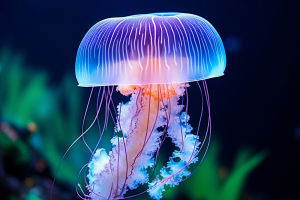Lykkers, embark on a journey into the captivating world of bioluminescence, where nature shines brightly with vibrant colors and mysterious life forms.
This remarkable phenomenon, predominantly witnessed in the deep blue seas and enchanting woodlands, blends chemistry with the magic of life.
Get ready to explore the stunning ways in which living organisms generate their own light and the science behind these spectacular displays!
What Is Bioluminescence?
Bioluminescence refers to the natural production of light by living organisms through a chemical reaction. This process is categorized as chemiluminescence, where light is emitted without significant heat. Known as "cold light," it possesses unique features that make it an intriguing subject for scientists and nature lovers alike.
Where It Shines
Most bioluminescent species inhabit the ocean, showcasing a dazzling array of bioluminescent fish, bacteria, and jellyfish. On land, wonders like fireflies and fungi join the ranks, while bioluminescent organisms are rarely found in freshwater environments.
Remarkably, the oceans are home to a near-infinite variety of glowing species waiting to be discovered.
The Science Behind the Glow
The process of bioluminescence relies on two key compounds: luciferin and either luciferase or photoprotein. Luciferin serves as the substrate that generates light, while luciferase functions as an enzyme assisting in the reaction. The color of the emitted light varies, influenced by the molecular structure of luciferin.
For example, yellow light is typical in fireflies, while lanternfish emit a greenish hue.
Unique Light Synthesis
Some organisms can naturally synthesize luciferin, such as certain dinoflagellates that radiate a stunning bluish-green glow. Others obtain luciferin through their diet or a symbiotic relationship with bacteria.
For example, some marine species, like squid, have established partnerships with bioluminescent bacteria housed in special light organs, producing captivating displays.
Sophisticated Chemistry
The luciferin-luciferase reaction constantly intrigues scientists. Light production varies depending on the type of luciferase present. Some reactions, however, involve photoproteins that can emit light without luciferase, depending on certain chemical interactions, such as the inclusion of calcium ions.
Different Types of Light
Bioluminescent organisms display a spectrum of colors, primarily in the blue-green range, particularly in the ocean, where conditions favor this hue. On land, fireflies greet dark nights with yellow and green tones, captivating onlookers with their mesmerizing patterns.
An exception is the railroad worm, which shines in red and green hues, showcasing the diversity of bioluminescent colors across species.
Survival Strategies
Bioluminescence serves crucial functions in the survival of various organisms. Predatory species utilize light to lure unsuspecting prey while others use it for defense. For instance, the vampire squid releases glowing mucus, confusing potential predators and creating an opportunity for escape.
Counterillumination Tactics
Many species adopt a clever form of camouflage known as counterillumination. Hatchetfish exemplify this strategy by adjusting the intensity of their bioluminescent organs to match the light filtering down from above, rendering them nearly invisible to looming predators lurking below.
Flashing for Attention
Some organisms, such as glow worms, emit light to communicate, often to warn potential predators of their toxicity. Fireflies employ flashing patterns to attract mates, with males showcasing distinct sequences to catch the attention of females nearby.
Bioluminescence Beyond Nature
Recent studies explore how bioluminescence may enhance human activities. The discovery of Green Fluorescent Protein (GFP) demonstrates the potential of bioluminescent properties in scientific research, allowing for visual tracking of genetic activities.
Additionally, the concept of bioluminescent trees or crops could revolutionize urban and agricultural environments, offering sustainable, glowing alternatives to conventional lighting.
Conclusion: The Light Within Us
Bioluminescence reveals the extraordinary interplay of life, chemistry, and environment, showcasing nature's ingenuity. As scientists delve deeper, the possibilities for harnessing these captivating light-producing reactions to create innovative solutions are immense.
Embracing the wonders of bioluminescence inspires curiosity and encourages exploration of how nature can inform and improve human life on Earth.

